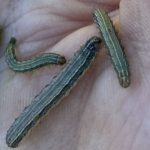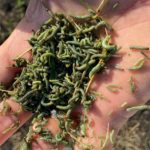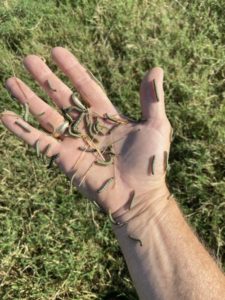 We are finding Fall Armyworms in many pastures and hay fields. In fields with above threshold numbers, this can reduce the hay yield or grass available for cattle grazing. I use a sweep net to sample and use an economic threshold of 25 worms per 5 sweeps. An alternative threshold is when worm counts exceed 2-3 per square foot.
We are finding Fall Armyworms in many pastures and hay fields. In fields with above threshold numbers, this can reduce the hay yield or grass available for cattle grazing. I use a sweep net to sample and use an economic threshold of 25 worms per 5 sweeps. An alternative threshold is when worm counts exceed 2-3 per square foot.
We sprayed an insecticide control trial last Wednesday near Port Lavaca (9/14/22). Results of the trial found most commonly used insecticides worked well. This includes pyrethroids like Lambda-Cyhalothrin, Lambda + Dimilin, Vantacor, Carbaryl, and Besiege. Notice some of the rates used in the trial are below labeled rates.
Another trial was conducted near College Station by Dr. David Kerns. The results for his trial were similar, including good control from Intrepid. The College Station trial also showed the short residual control of the pyrethroids where the worm numbers increased in the pyrethroid treated plots at 7 days after application.
Fall Armyworm Control in Pastures
Dalton C. Ludwick, Sonja L. Swiger, and David L. Kerns
Extension Entomologists, Texas A&M AgriLife Extension Service
Biology and Damage
There are two strains of fall armyworms (FAW): the corn strain and the grass strain. The corn strain usually appears in the spring and early summer and feeds on crops such as corn, sorghum, and cotton. The grass strain, which is the strain that infests hay fields and pastures, generally shows up after significant rain events from mid-July through fall. The corn strain is known for being resistant to pyrethroids, while the grass strain is susceptible to pyrethroids. FAW caterpillars survive and develop better in areas with fertilized or well-watered grasses which can lead to outbreak scenarios. Multiple generations can occur in a short time-period.
FAW caterpillars live for two to four weeks depending on the temperature. Freshly emerged caterpillars will begin to feed on the leaves and make small transparent areas (windowpanes; Fig. 1) giving the grass a frosted appearance. As they grow and molt, the caterpillars will begin to consume the entire leaf. The larger the caterpillar, the more damage they cause. Smaller caterpillars are easier to control. During their last few days as a caterpillar, when they are 1-1.5” in length, they consume about 80% of all the leaf tissue they will consume in their lifetime.
Identification and Scouting
FAW caterpillars are primarily identifiable by two features. The head will have apparent white markings that form an upside down “Y” pattern (Fig. 2). The second feature is that the last couple segments of the caterpillar will have black bumps that form a square or rectangle.
 There are multiple methods that are available to scout for FAW caterpillars. The more common method is to get on your hands and knees and closely inspect the grass. During hot days, check the lower parts of the plant or soil surface where they may be hiding from the harsh temperatures. Sweep nets are a very good and easy to use tool for sampling for FAW in tall grass (Fig. 3). Another method is to run your hands across a 1-2 square foot area and knock the caterpillars to the soil surface. Then, simply inspect the soil for dislodged caterpillars.
There are multiple methods that are available to scout for FAW caterpillars. The more common method is to get on your hands and knees and closely inspect the grass. During hot days, check the lower parts of the plant or soil surface where they may be hiding from the harsh temperatures. Sweep nets are a very good and easy to use tool for sampling for FAW in tall grass (Fig. 3). Another method is to run your hands across a 1-2 square foot area and knock the caterpillars to the soil surface. Then, simply inspect the soil for dislodged caterpillars.
Regardless of the scouting method, take note of the size of the caterpillars. Smaller caterpillars (<1/2 inch) are less damaging. Larger caterpillar (>1/2 inch) should be treated soon to prevent greater damage. If using a sweep net, then treat at 2 or more caterpillars ½ inch or larger per sweep. If making visual inspections, then treat if you have 2 or more FAW caterpillars per square foot. If you are picking up larger numbers of small caterpillars, then treatment is also justified. Most of the time fields are either well below or well above threshold.
Control Options
If the grass is being used for hay and is near harvest, then harvest early to prevent extra feeding damage. However, be aware that the caterpillars may consume the cut hay, so this is not always a wise option.
 Insecticide applications should be made early in the morning or late in the evening if possible, to ensure caterpillars come into contact with insecticide. During hotter parts of the day, caterpillars may be out of the canopy and avoid maximum insecticide exposure.
Insecticide applications should be made early in the morning or late in the evening if possible, to ensure caterpillars come into contact with insecticide. During hotter parts of the day, caterpillars may be out of the canopy and avoid maximum insecticide exposure.
There are many insecticides that can be used to control FAW caterpillars. Pyrethroids are relatively cheap and readily available. These insecticides take roughly three days to achieve maximum effectiveness against small and large caterpillars. Pyrethroid insecticides tend to have a short residual period and can be washed off by rains. This lack of rain fast protection can be a problem with the recent weather and possible overlapping generations of fall armyworm caterpillars. Addition of a product like Dimilin (or generic products with diflubenzuron) can increase the residual control period to 10-12 days, eliminating caterpillars that emerge in that timeframe. Neither pyrethroids nor Dimilin will continue providing control if rain occurs though. Another fairly inexpensive option is Intrepid (or generic products with methoxyfenozide). This product will provide residual control for about 7 days, but it must be eaten to kill the caterpillar and is not rain fast.
If rain is a continuous issue, the only truly rain fast options are products such as Prevathon, Vantacor, or Besiege. All of these products contain the active ingredient chlorantraniliprole, but Besiege also contains a pyrethroid. These products are absorbed by the leaf tissue and are rain fast upon drying. While these products are more expensive, they do provide excellent residual activity and will persist longer at the higher rate. For example, Prevathon at 14 fl-oz/ac will typically provide 14 days control, and a 20 fl-oz/ac rate will provide 20-21 days of control.

